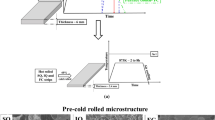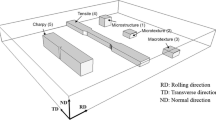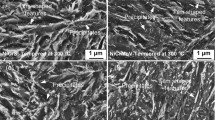Abstract
Four medium carbon and low-alloy steels were hardened through oil and forced air cooling. Tempering was then performed in the temperature range 250-600 °C. The martensite content increased with an increased hardenability and/or the rate of cooling. Tempering at T > M s caused a gradual decline in both hardness and strength and an improvement in the Charpy V-notch impact toughness. The low-alloy steels underwent tempered martensite embrittlement (as a result of the formation of carbides at the martensite interlaths and prior austenite grain boundaries) and enhancement of phosphorus segregation (particularly in the presence of Ni). Higher hardenability steels were found to be better hardened via the more recent forced air quenching rather than the conventional oil quenching. In this work, a modest, novel attempt is presented to empirically correlate the impact toughness with the hardness measurements to enable future prediction of impact toughness from hardness measurements.






Similar content being viewed by others
References
ASM Handbook Committee et al., Classification and designation of carbon and low-alloy steels, ASM handbook, Properties and Selection: Irons, Steels, High-Performance Alloys, Vol 1, 10th ed., K.M. Zwilsky, Ed., ASM International, Materials Park, 1991, p 140–194
W.D. Callister, Materials Science and Engineering: An Introduction, 7th ed., Wiley, New York, 2007, p 311–315
C.E. Bates, G.E. Totten, R.L. Brennan et al., Heat treating, Heat Treating, Vol 4, 10th ed., S.M. Copley, Ed., ASM International, Materials Park, 1990, p 67
R. Abbaschian, L. Abbaschian, and R.E. Reed-Hill, Physical Metallurgy Principles, 4th ed., Cengage Learning, Connecticut, 2009, p 562
Z. Altagoury, M.T. Abdu, M.A. Adly, and A. Elhabak, Electrolytic Surface Hardening of DIN 42CrMo4 (AISI, 4140) Medium Carbon Low Alloy Steel, Int. J. Adv. Eng. Technol. Comput. Sci. (IJAETCS), 2014, 1, p 20–27
Y. Lu, A Study on Gas Quench Steel Hardenability, M.S. Thesis, Worcester Polytechnic Institute, Worcester, MA, USA, 2015.
ASTM A255-10(2014), Standard Test Methods for Determining Hardenability of Steel, ASTM International, West Conshohocken, PA, 2014.
ASTM E140-12be1, Standard Hardness Conversion Tables for Metals Relationship Among Brinell Hardness, Vickers Hardness, Rockwell Hardness, Superficial Hardness, Knoop Hardness, Scleroscope Hardness, and Leeb Hardness, ASTM International, West Conshohocken, PA, 2012.
M. Gojic, L. Kosec, and P. Matkovic, The Effect of Tempering Temperature on Mechanical Properties and Microstructure of Low Alloy Cr and CrMo Steel, J. Mater. Sci., 1998, 33, p 395–403
W.S. Lee and T.T. Su, Mechanical Properties and Microstructural Features of AISI 4340 High-Strength Alloy Steel Under Quenched and Tempered Conditions, J. Mater. Process. Technol., 1999, 87, p 198–206
G. Krauss, Tempering of martensite, Encyclopedia of Materials Science and Technology, 2nd ed., Elsevier, New York, 2001, p 9093–9097
G. Krauss, Martensite in Steel: Strength and Structure, Mater. Sci. Eng. A, 1999, 273–275A, p 40–57
D. Chaouch, S. Guessasma, and A. Sadok, Finite Element Simulation Coupled to Optimisation Stochastic Process to Assess the Effect of Heat Treatment on the Mechanical Properties of 42CrMo4 Steel, Mater. Des., 2012, 34, p 679–684
W.J. Nam, D.S. Kim, and S.T. Ahn, Effect of Alloying Elements on Microstructural Evolution and Mechanical Properties of Induction Quenched-and-Tempered Steels, J. Mater. Sci., 2003, 38, p 3611–3618
R. Honeycombe and H.K.D.H. Bhadeshia, Steels: Microstructure and Properties, 2nd ed., Edward Armold, London, 1996
T.V. Rajan, C.P. Shama, and A. Sharama, Heat Treatment Principles and Techniques, Prentice-Hall of India private Ltd., New Delhi, 1998
G.F. Vander Voort, Atlas of Time-Temperature Diagrams for Irons and Steels, ASM International, Ohio, 1991
D.R. Askeland and P.P. Fulay, Essentials of Materials Science and Engineering, 2nd ed., Cengage Learning, Ontario, 2009, p 391
B.A. Miller et al., Overload failures, ASM Handbook, Failure Analysis and Prevention, Vol 11, 10th ed., G.H. Geiger, Ed., ASM International, Materials Park, 1954,
R.M. Horn and R.O. Ritchie, Mechanisms of Tempered Martensite Embrittlement in Low Alloy Steels, Metall. Trans. A, 1978, 9, p 1039–1053
S. Raoul, B. Marini, and A. Pineau, Effect of Microstructure on the Susceptibility of A533 Steel to Temper Embrittlement, J. Nucl. Mater., 1998, 257, p 199–205
A.K. Sinha, Physical Metallurgy Handbook, 1st ed., McGraw Hill, New York, 2003
K.B. Lee, S.H. Yoon, and H. Kwon, On the Transgranular Type of Tempered Martensite Embrittlement, Scr. Metall. Mater., 1994, 30, p 1111–1115
G. Thomas, Retained Austenite and Tempered Martensite Embrittlement, Metall. Mater. Trans. A, 1978, 9, p 439–450
H. Kwon and C.H. Kim, Tempered Martensite Embrittlement in Fe-Mo-C and Fe-W-C Steel, Metall. Mater. Trans. A, 1983, 14, p 1389–1394
H.K.D.H. Bhadeshia and D.V. Emonds, Tempered Martensite Embrittlement: Role of Retained Austenite and Cementite, Metal Sci., 1979, 13, p 325–334
J.A. Peters, J.V. Bee, B. Kolk, and G.G. Garrett, On the Mechanisms of Tempered Martensite Embrittlement, Acta Metall., 1989, 37, p 675–686
C.L. Briant and S.K. Banerji, The Fracture Behavior of Quenched and Tempered Manganese Steel, Metall. Mater. Trans. A, 1982, 13, p 827–836
H. Kwon and C.H. Kim, Consideration on the Intergranular Tempered Martensite Embrittlement, Metall. Mater. Trans. A, 1984, 15, p 393–395
M. Sarikaya, A.K. Jhingan, and G. Thomas, Retained Austenite and Tempered Martensite Embrittlement in Medium Carbon Steel, Metall. Mater. Trans. A, 1983, 14, p 1121–1133
J.P. Materkowski and G. Krauss, Tempered Martensite Embrittlement in SAE 4340 Steel, Metall. Mater. Trans. A, 1979, 10, p 1643–1651
S. Suzuki, M. Tanino, and Y. Waseda, Phosphorus and Boron Segregation at Prior Austenite Grain Boundaries in Low-Alloyed Steel, ISIJ Int., 2002, 42, p 676–678
M.A. Islam, M. Novovic, P. Bowen, and J.K. Knott, Effect of Phosphorus Segregation on Fracture Properties of 2.25Cr-1Mo Pressure Vessel Steel, J. Mater. Eng. Perform., 2003, 12, p 244–248
F.A. Darwish, L.C. Pereira, C. Gatts, and M.L. Graça, On the Tempered Martensite Embrittlement in AISI, 4140 Low Alloy Steel, Mater. Sci. Eng. A, 1991, 132, p L5–L9
C.L. Briant and S.K. Banerji, The Effect of Molybdenum on Tempered Martensite Embrittlement, Scr. Metall. Mater., 1979, 13, p 813–816
S.H. Song, R.G. Faulkner, and P.E.J. Flewitt, Quenching and Tempering Induced Molybdenum Segregation to Grain Boundaries in a 2.25Cr-1Mo Steel, Mater. Sci. Eng. A, 2000, 281, p 23–27
L. Li, E.B. Liu, Q.F. Li, and Z. Li, Non Equilibrium Grain Boundary Cosegregation of Mo and P, Appl. Surf. Sci., 2006, 252, p 3989–3992
A.J. Papworth and D.B. Williams, Segregation to Prior Austenite Grain Boundaries in Low Alloy Steels, Scr. Mater., 2000, 42, p 1107–1112
S. Maropoulos, N. Ridley, and S. Karagiannis, Structural Variation in Heat Treated Low Alloy Steel Forgings, Mater. Sci. Eng. A, 2004, 380, p 79–92
M.J. Peet, Transformation and Tempering of Low-Temperature Bainite, Ph.D. Dissertation, University of Cambridge (2010).
Author information
Authors and Affiliations
Corresponding author
Additional information
An erratum to this article can be found at http://dx.doi.org/10.1007/s11665-016-2336-5.
Rights and permissions
About this article
Cite this article
Hussein, AH.A., Abdu, M.T., El-Banna, ES.M. et al. Interrelation of Steel Composition, Hardening Route, and Tempering Response of Medium Carbon Low-Alloy Steels. J. of Materi Eng and Perform 25, 1463–1473 (2016). https://doi.org/10.1007/s11665-016-1957-z
Received:
Revised:
Published:
Issue Date:
DOI: https://doi.org/10.1007/s11665-016-1957-z




